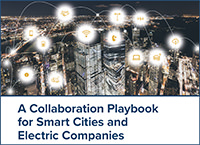
It is becoming increasingly clear that smart, digital cities will have an economic advantage over old-fashioned, analog communities. If you’re looking to accelerate your progress, there’s no better place to look than your local power utility.
There are a number of great success stories already. But your city could be the next success story.
 The Smart Cities Council has teamed up with Edison Electric Institute to develop a free collaboration playbook that collects great examples of city/electric company partnerships and outlines some proven steps to forge your own.
The Smart Cities Council has teamed up with Edison Electric Institute to develop a free collaboration playbook that collects great examples of city/electric company partnerships and outlines some proven steps to forge your own.
We’re printing a short except of the introduction below, but make sure to download and read the guide and share it with your leadership team. There’s no better way to accelerate your smart cities efforts. — Jesse Berst
Why is the city-electric company connection so powerful? First, because electricity influences all aspects of our lives and economic activity, including economic development. Second, because city-electric company partnerships are the single biggest opportunity to make smart cities achievable by sharing infrastructure, costs, and data.
Last, and most important, the partnership has the potential to make a positive impact and improve the quality of life for families and individuals.
Electric Companies
There’s no better partner for a city than an electric company.
Infrastructure. In the last decade, electric companies have made significant investments in both physical assets and digital capabilities in order to make the energy grid smarter, stronger, cleaner, more dynamic, and more secure. These investments are opportunities to be leveraged by cities so that they can integrate more infrastructure systems in the future.
Experience. The electric power industry has a great deal of experience ensuring reliability while incorporating new technologies. The industry was the first to install large area communications networks, sensors, and smart meters, and to learn how to gather, store, safeguard, and analyze massive quantities of data.
Stability. Electric companies want their cities to succeed. They are invested in the long-term well-being of their communities as anchor institutions with substantial physical infrastructure, local workforces, and stakeholder relationships. In addition, they are charged with maintaining security, reliability, affordability, and reliability for customers and citizens.
Cities
Cities, meanwhile, have much to offer electric companies.
Infrastructure. We’re not just talking about roads and bridges. As more cities invest in smart city and public safety initiatives, they are making substantial investments in their networks, which connect many disparate systems.
Community. By their very nature, cities bring together diverse groups of stakeholders for a common good. They are adept at gathering feedback and working to build consensus among competing interests and viewpoints. Cities can bring together businesses, residents, and the electric companies that serve them in a way that no other entity can.
Purpose. Cities also are trying to meet their citizens’ expectations for a sustainable, resilient, convenient and safe place to live — expectations that are becoming more challenging to meet as cities worldwide are housing an increasingly larger percentage of the world’s population. Cities are motivated to partner to be able to do more with less.
Shared Goals and Opportunities
Cities are stepping up their investments in smart city initiatives for reasons ranging from economic development and quality of life to sustainability. Meanwhile, U.S. electric companies spend more than $100 billion annually on transmission and distribution infrastructure improvements for similar reasons. While cities and electric companies are making progress individually, they could unlock much more value by working together.
During an EEI workshop of electric company smart community leaders in 2018, attendees agreed that a driving factor was that current electric systems could provide additional value – such as cost-effective services and data. In addition, things like the physical wires, rights of ways, and the electric distribution system can serve as a real foundation for the beginning of a smart city.
Learn how in the free guide, A Collaboration Playbook for Smart Cities and Electric Companies: An executive guide to partnership opportunities.



